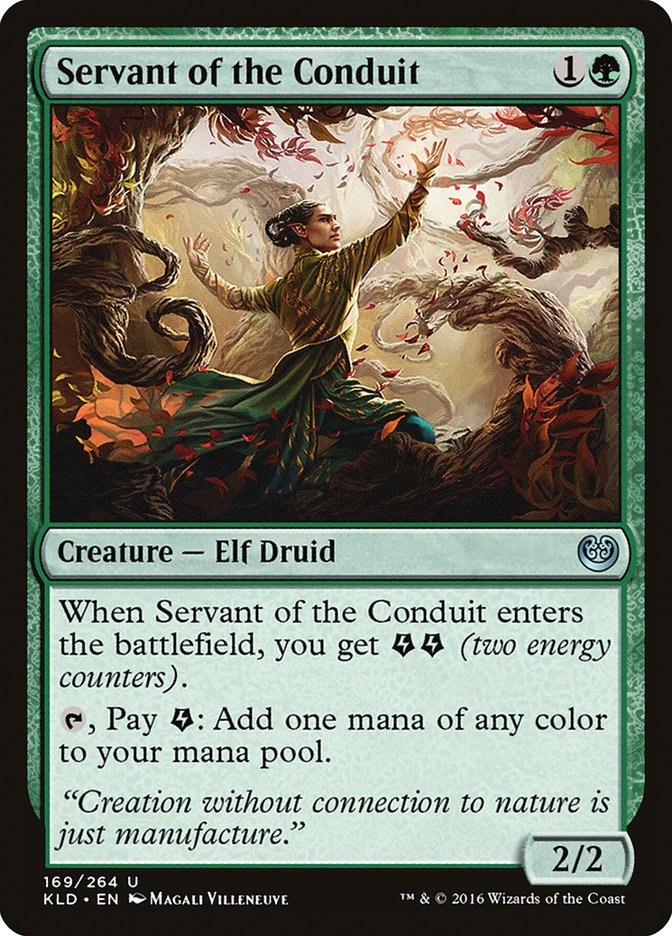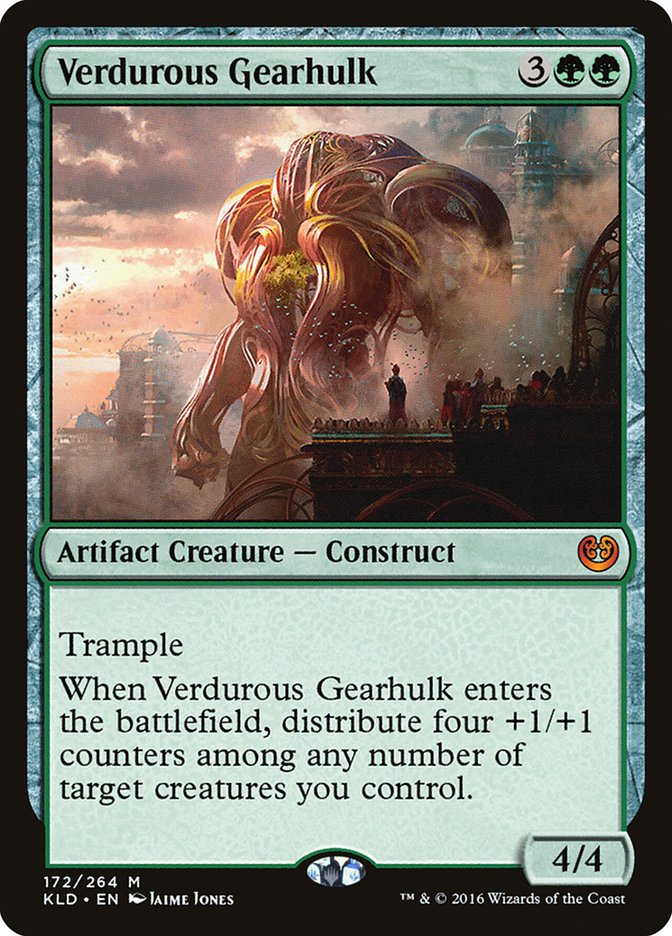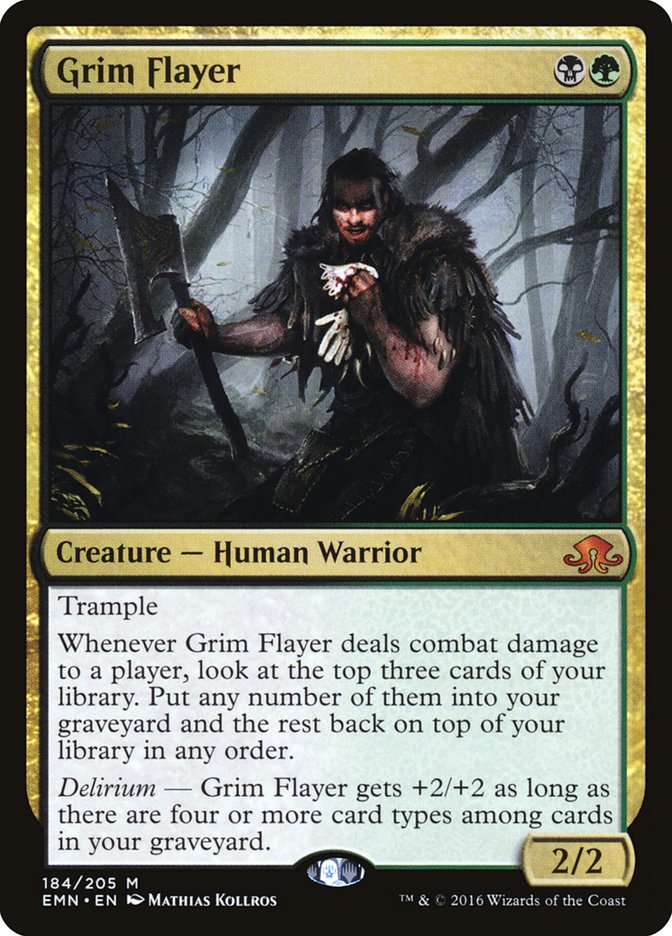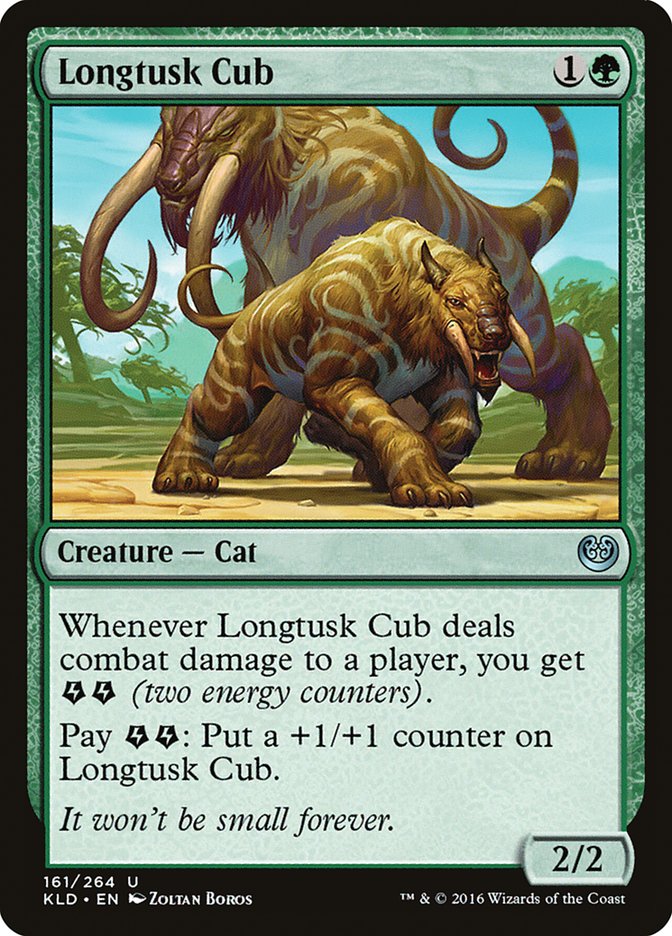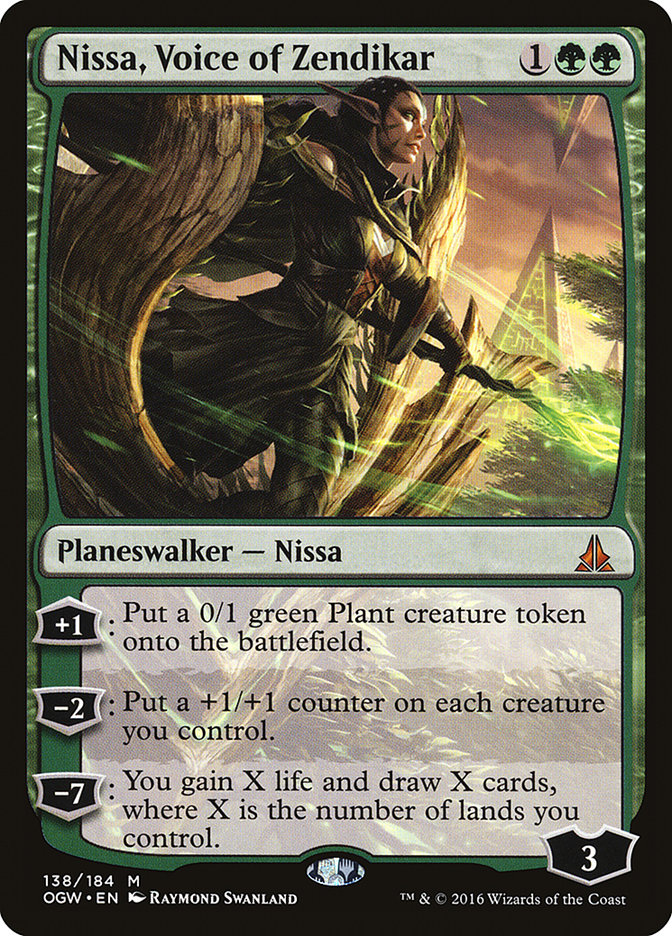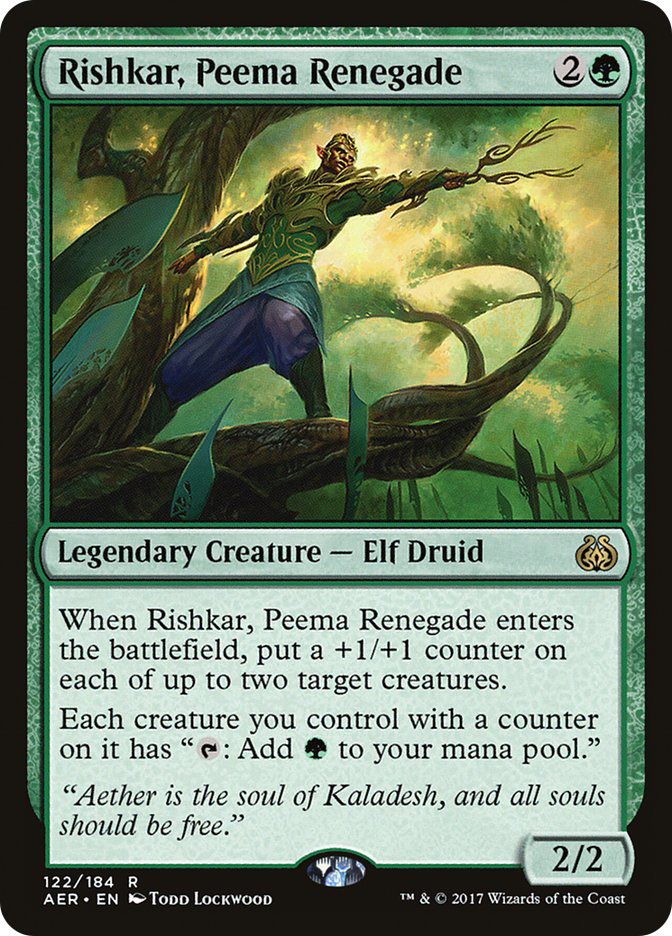I begin today quite conflicted. Every morsel of my being believes wholeheartedly that the list of B/G I’m about to show you is the best Standard deck choice in the here and now. The issue is I share that opinion with no one close to me.
Like flavors of ice cream, everyone else just plays and believes in different cards. I try them and fail. They try mine and fail. That’s why last week I promoted a differing version of the deck from what I used in all of my tournaments.
I was afraid to be wrong, but that changes now.
My win percentage with the deck is a consistent 80%, and I believe in all the strategies I execute. Today I give them all to you to do with as you please.
Creatures (25)
- 4 Tireless Tracker
- 2 Gonti, Lord of Luxury
- 4 Verdurous Gearhulk
- 4 Servant of the Conduit
- 4 Winding Constrictor
- 3 Glint-Sleeve Siphoner
- 4 Walking Ballista
Lands (24)
Spells (11)

First and foremost, the baseline argument against this list has been Servant of the Conduit. It’s a low-powered two-drop in a format with Fatal Push. This makes the reward of investing in Servant of the Conduit on turn 2 lower, since later in the game it only gets worse to draw. While true, the benefits of this card are often overlooked. For starters, Servant of the Conduit is a great two-drop on the draw when removal is lacking or unnecessary at the time. It allows you to get to the stage of casting more than one spell a turn earlier, while also ramping to important creatures like Gonti, Lord of Luxury and Verdurous Gearhulk.
Servant of the Conduit also plays an important role in the light energy package the deck supports. While Aether Hub can cause issues here and there, it has greatly increased the number of hands that can be kept versus if those four lands were replaced with basics. At that point, cards like Attune with Aether would enter the conversation, but I am not a fan of supporting a larger energy theme to make that card worth playing.
Aethersphere Harvester is also a card I’ve had great success with that Servant of the Conduit works very well with. Not only does the two-drop get another job to do in the form of crewing the vehicle, but it also fuels the ability to gain lifelink. Lastly, both of these cards’ energy can be turned into cards when Glint-Sleeve Siphoner survives the turn cycle. It’s not the most sophisticated use of energy, but it is elegant in its simplicity.
Moving past one mana-making creature finds us talking about another: Rishkar, Peema Renegade, a “sacred cow” staple that sees play in every variation of the deck, but one I’ve just never had much success with. Obviously I know the card’s ceiling is high, but that’s only when a multitude of conditions are met. You have to be on the play, draw both it and Winding Constrictor, and have both live through the trigger for the dream to be lived. It’s great when it happens, but the percentage it does is just too low.
In other builds, you have cards like Sylvan Advocate, Grim Flayer, and Longtusk Cub that can greatly benefit from the +1/+1 counter, but I’ve deemed them worse than the build I prefer. It was a tough card to cut, given the social pressure to play it, but I’ve been very happy with the decision ever since.
So now that I’ve explained the main contention points I hear about the deck, we can finally move into why this is the version I prefer. Anyone who has followed me through my career may already be able to guess it: I like building my decks to be able to win on the draw.
Instead of playing powerful cards like Nissa, Voice of Zendikar; Rishkar, Peema Renegade; Grim Flayer; or Longtusk Cub, I opt to play more flexible cards that can steal games when on the back foot. That’s why I seem to be the only one out there that likes Servant of the Conduit and Aethersphere Harvester. Both of these cards are great ways to catch back up but are underpowered when on the play compared to the cards previously mentioned.
It’s really that simple.
This level of commitment to one issue has made the deck very good against both Mardu Vehicles and all variants of B/G Constrictor, yet severely lacking against Jeskai Saheeli Game 1. I’ve found it to be a net positive to sacrifice Game 1 to the already difficult matchup and try to win both sideboarded games with a very heavy sideboard for the matchup.
I don’t want to bore you with even more theory on the deck today. Many players have asked me for sideboard guides and other operational questions, and that’s exactly what I want to accomplish today!
B/G Constrictor
Explaining how to play the B/G Constrictor “mirrors” can get pretty convoluted given how many variations there are out there, but there are simple rules that I follow regardless of what variation I’m against, the biggest being when to play Tireless Tracker.
Over time we’ve become conditioned to play this card on turn 4 so that we at least get minimal value out of it, but that’s commonly not correct to do anymore. 50% or more of the “mirror’s” removal is in the form of Fatal Push that can’t answer it that early in the game, and anything else will take up an opponent’s entire turn to answer. Not only that, but turn 3 Tireless Tracker curves much more strongly with the rest of the deck. I often find myself playing Winding Constrictor on turn 4 and threatening to make Tireless Tracker a 5/4 in combat before casting another two-drop during the second main phase. The “stranded” Clues end up being a boon later in the game, turning on revolt for Fatal Push.
Another line that I’ve been very happy with while on the play is not casting my two-drop creature on turn 2 and instead holding up mana to kill theirs when I have access to Aethersphere Harvester for turn 3. This puts the opponent into an interesting predicament on their turn 2. They will usually just cast their creature into your open mana, but I’ve found them to think for a while before passing with open mana whenever they have a Grasp of Darkness.
You not only get to strand their mana for the first couple turns and sniff out the Grasp of Darkness, but also present a threat that could dictate the rest of the game. This sets up strong Tireless Trackers and Verdurous Gearhulks in the later turns, given that neither player did much of anything in the earliest of turns. It also means you most likely stranded a Fatal Push in their hand that they will do their best to use on Aethersphere Harvester. Good thing crewing your vehicle is not a must!
Sideboarding
Out:
In:
If they have Aethersphere Harvester as well:
Out:
In:
Glint-Sleeve Siphoner is guaranteed bad on the draw, but I do sometimes bring it back in for Game 3 when on the play if I didn’t see any Walking Ballistas. I’ve done this, but I’m still unsure if it’s correct. If your plan is to listen to me unconditionally, then I would err on the side of caution and just leave them in the sideboard.
Walking Ballista isn’t bad per se, but it’s not as high-impact as you would normally need it to be. I don’t mind keeping in a few to combo with Winding Constrictor or to act as a four-mana Ruinous Path against Ob Nixilis Reignited, but for the most part it’s a weak link.
I’ve found taking a more controlling approach in the mirror to be a good thing. The build supports this strategy with four Tireless Trackers; three Gonti, Lord of Luxury; and two Ob Nixilis Reignited. Winding Constrictor is too much of a synergistic card to lean on in the mirror, given both decks’ density of removal. I’d much rather my approach be that like a Modern midrange “mirror” and have an excess of card advantage and removal spells. This can sometimes backfire when an opponent leads on turn 3 Nissa, Voice of Zendikar on the play, but not much really beats that when backed by a good draw.
Mardu
There’s really not much strategic advice for this Game 1 matchup, given how aggressively it played out. It’s just a difficult technical matchup half the time and someone bashing skulls the rest of the time. All that I can really say is I believe my list to be a nightmare for them compared to the other versions of B/G. We don’t have cards like Nissa, Voice of Zendikar, but instead have three Aethersphere Harvesters, which is a pain for them to deal with. They can of course run us over on the play, but that’s the reward for playing Mardu Vehicles. Usually on the draw the deck can’t really find a reasonable line for victory against a reasonable start out of my deck.
Sideboarding: On the Draw
Out:
In:
Mardu Vehicles will keep a slightly aggressive curve in their deck but also have whatever top-end they deem correct at the time. Currently that seems to be five planeswalkers, a couple of Fumigates, and either one or two Skysovereign, Consul Flagship. They usually cut Inventor’s Apprentice, and I’ve noticed most of my opponents trim on other cards to make room.
You have to respect the aggression but also prepare for turn 4 Gideon, Ally of Zendikar, something I’m sick of saying after almost two years. Things usually go bad when they curve out, but that’s rarer than one would think, thanks to their shaky manabase.
Sideboarding: On the Play
Out:
In:
Don’t buy into the fear of aggression when on the play. That’s what they hope is going to happen as spot removal rots in your hand while you lose to Gideon, Ally of Zendikar and Scrapheap Scrounger. Their plan is to get you to overextend into Fumigate or pick off your timid threats one at a time with removal and Skysovereign, Consul Flagship.
You won’t get run over in the early-game, so why keep so much removal in your deck? Instead, fight them with Tireless Tracker; Gonti, Lord of Luxury; and Aethersphere Harvester. These cards give us an advantage while also interacting with the game.
Jeskai Saheeli
Game 1 is laughably bad. You can win a game, but it often involves some misfire from their end. We have too much cheap removal, Vehicles that gain life, and a Gearhulk that is the epitome of overextending into mass removal. It’s just horrible!
Luckily, we have a plan!
Sideboarding
Out:
In:
(This is the same sideboard plan against Dynavolt Tower decks, but add two Natural Obsolescence.)
The sideboard Gonti, Lord of Luxury was briefly changed to Painful Truths, but I found it important to have a density of creatures they don’t want to kill with spot removal so that you have adequate fodder for Distended Mindbender. The “black” Eldrazi has done wonders to the matchup and is something I regret not trying before the Pro Tour and Grand Prix, given 40% of my losses in those two events were to Jeskai variants.
Games tend to have a ton of interaction and take about ten to thirteen turns to finish. It’s a dream for anyone who likes to play Magic. The only problem is that it’s extremely taxing to play from our side. Sequencing spells correctly can be a challenge, since at any point they can present a combo to kill us. I highly suggest you practice this matchup before going into an event. Often you will have a plethora of options for each decision that have context in the game, which makes it impossible for me to try and help you play the games better by using words in an article.
Four-Color Saheeli
This matchup is as challenging as it is fair from both sides unless they cast Oath of Chandra on turn 2. I’ve never beaten that card in my entire life out of this deck. It’s seriously busted. Outside of those games, we can run them over on the play with fast Servant of the Conduit starts or anytime Verdurous Gearhulk bulks up the Ballista.
I believe B/G to be quite unfavored in this matchup, but in all honesty it’s the one I have the least experience with. I will be prepared by the time I have another tournament, but that isn’t until Grand Prix New Jersey. Don’t worry. You’ll get the memo before then if I figure anything out.
Sideboarding
Out:
In:
This is what I’ve been doing in tournament settings to above-average success. My next exploration is to try Ob Nixilis Reignited when on the play, but I don’t want to make my deck too expensive. Like I said before, I will be working diligently on this matchup specifically, since I believe it to be getting popular and something we must answer for future success. I’m open to suggestions on how to attack this matchup!
That’s pretty much all I have to say on the deck. In the end, I understand that you’ll either love it or hate it, and there’s not much I can do about that. I still believe there’s a chance I’m wrong about what is the best version of B/G, but changing my ways would involve losing, which is something I’m not doing with the deck. I just hope I was able to answer all the questions you had on the list. Good luck at the Classic in Indianapolis this weekend!


